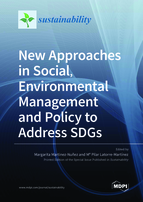New Approaches in Social, Environmental Management and Policy to Address SDGs
A special issue of Sustainability (ISSN 2071-1050). This special issue belongs to the section "Sustainable Management".
Deadline for manuscript submissions: closed (1 November 2021) | Viewed by 47304
Special Issue Editors
Interests: digital transformation; data envelopment analysis (DEA); business and management; environmental economics
Special Issues, Collections and Topics in MDPI journals
Special Issue Information
Dear Colleagues,
The SDGs (Sustainable Development Goals) are principles created by the UN, with the ultimate goal of guaranteeing well-being on and off the planet. The importance of these objectives is essential, not only for promoting environmental education and citizen science, but also for the commitment to the solutions at different levels of governments, companies, and civil society.
Among the SDGs, there are goals that both public and private organizations must meet before 2030, all with the aim of causing a positive impact on society. Policy makers, companies, and organizations, are challenged to cooperate to define new regulations, change business models, and promote the adaptation of society to the challenges posed by the 17 SDGs.
This Special Issue welcomes papers, research works, and investigations on new approaches to address SDGs from a more macro perspective—environmental, social, and governance (ESG) criteria.
This Special Issue pays attention to the following topics of interest, but is not limited to them:
- Regulations on the shipment of waste: the missing link
- Natural resources management and environmental policies
- Digital transformation and organizational management triggered by SDGs
- Network analysis: behaviour of communities in innovation and other parameters
- Smart circular economy
- Social dialogues to identify the accelerators to address SDGs
- Rural community perceptions and attitudes towards sustainability
Dr. Margarita Martinez-Nuñez
Dr. Mª Pilar Latorre-Martínez
Guest Editors
Manuscript Submission Information
Manuscripts should be submitted online at www.mdpi.com by registering and logging in to this website. Once you are registered, click here to go to the submission form. Manuscripts can be submitted until the deadline. All submissions that pass pre-check are peer-reviewed. Accepted papers will be published continuously in the journal (as soon as accepted) and will be listed together on the special issue website. Research articles, review articles as well as short communications are invited. For planned papers, a title and short abstract (about 100 words) can be sent to the Editorial Office for announcement on this website.
Submitted manuscripts should not have been published previously, nor be under consideration for publication elsewhere (except conference proceedings papers). All manuscripts are thoroughly refereed through a single-blind peer-review process. A guide for authors and other relevant information for submission of manuscripts is available on the Instructions for Authors page. Sustainability is an international peer-reviewed open access semimonthly journal published by MDPI.
Please visit the Instructions for Authors page before submitting a manuscript. The Article Processing Charge (APC) for publication in this open access journal is 2400 CHF (Swiss Francs). Submitted papers should be well formatted and use good English. Authors may use MDPI's English editing service prior to publication or during author revisions.
Keywords
- Sustainable Development Goals
- sustainable businesses
- information and communication technologies
- cleaner production
- environmental management
- ecoefficiency
- smart solutions for sustainability







